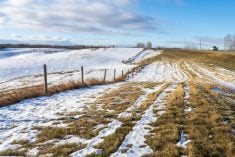MELITA, Man. — Bending over carefully so he wouldn’t drop the microphone, Scott Chalmers reached down to pick up a metre long plant lying on the ground.
Chalmers, a diversification specialist with Manitoba Agriculture, held the plant high above his head to show it to the 60 people attending the Westman Agricultural Diversification Organization field day held near Melita July 30.
The leafy plant was something that western Canadian farmers rarely see: giant ragweed.
“It probably came up from the U.S. through the Souris River somehow,” Chalmers said during an interview following the field tour.
Read Also

Federal budget draws mixed reaction from Canadian agriculture groups
The 2025 federal budget took a step forward in recognizing agriculture’s importance but failed to address pressing challenges like labour disruptions, interswitching and precision technology, say Canadian farm groups.
“Last year we found three plants and this year we found about a dozen plants.”
Chalmers found the giant ragweed on a field south of Melita in the Souris River Valley. Severe flooding in 2011 likely carried seeds or plants into the flat-bottomed valley, but Chalmers doesn’t know exactly how the weed made its way to southwestern Manitoba.
“It’s bizarre that it’s this far to the northwest of where it usually is. It’s almost one state out of its place.”
Giant ragweed, also known as horseweed, is commonly found in the U.S. Midwest and the American south, but its northerly range is typically southeastern North Dakota.
Hugh Beckie, an Agriculture Canada weed scientist from Saskatoon, said he’s never heard of giant ragweed on the Canadian Prairies.
“Looking at the general weed surveys that my colleague Julia Leeson has done, I don’t believe that they detected that species.”
Chalmers has found Giant Ragweed on only one field near Melita, but he suspects it’s also growing on fields further south in the Souris River Valley.
“I’ll bet if you go up the river, upstream, you will find it for sure.”
Chalmers said high water levels flooded many fields in the valley this year. Weeds took over those fields, which may have allowed giant ragweed to get established.
The weed’s arrival remains a curiosity because only a few weeds have been found, but Chalmers said prairie growers should be concerned.
“Potentially, this could be a climate change signal or marker,” he said.
“Some of these things that are problems further south might be coming further north and potentially affecting us.”
Beckie agreed, noting that giant ragweed, which loves heat, could flourish in Western Canada.
“With our warmer winters, we might see weeds that aren’t typically well adapted to the Prairies encroach into the Prairies,” he said.
“We’ve documented this with other species (including kochia).”
He said the weed’s arrival is a threat to prairie agriculture because glyphosate resistant giant ragweed has been found in a number of American states and in southwestern Ontario.
Last year, Chalmers conducted an informal test on a giant ragweed plant he found near Melita. He sprayed glyphosate on the weed with a bottle, and it died two and a half weeks later.
“I was fairly satisfied that is wasn’t (glyphosate resistant), but you never know.”
Beckie said it would be wise to eradicate the giant ragweed plants near Melita.
“That would be very cost effective,” he said.
“If it gets established and does become adapted, it could pose a lot of challenges for us.”
Giant ragweed facts:
• Giant ragweed, also known as horseweed, is native to North America.
• It is the most common cause of hay fever in eastern North America. A single plant can produce up to one billion grains of pollen.
• It typically grows to a height of 1.5 metres, but it can grow more than five metres tall.
• Just one ragweed plant per sq. meter has been shown to reduce crop yields 45 to 77 percent.
• Giant ragweed is one of the dominant weed species in the U.S. Midwest and is the most important weed in the eastern corn belt.
• Glyphosate resistant giant ragweed has been found in Ontario, Ohio, Indiana, Arkansas, Kansas, Minnesota, Tennessee, Iowa, Mississippi, Nebraska, Wisconsin and Missouri.
Source: staff research















